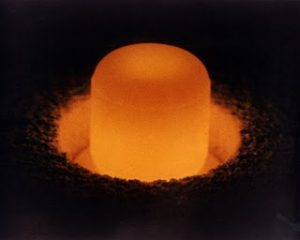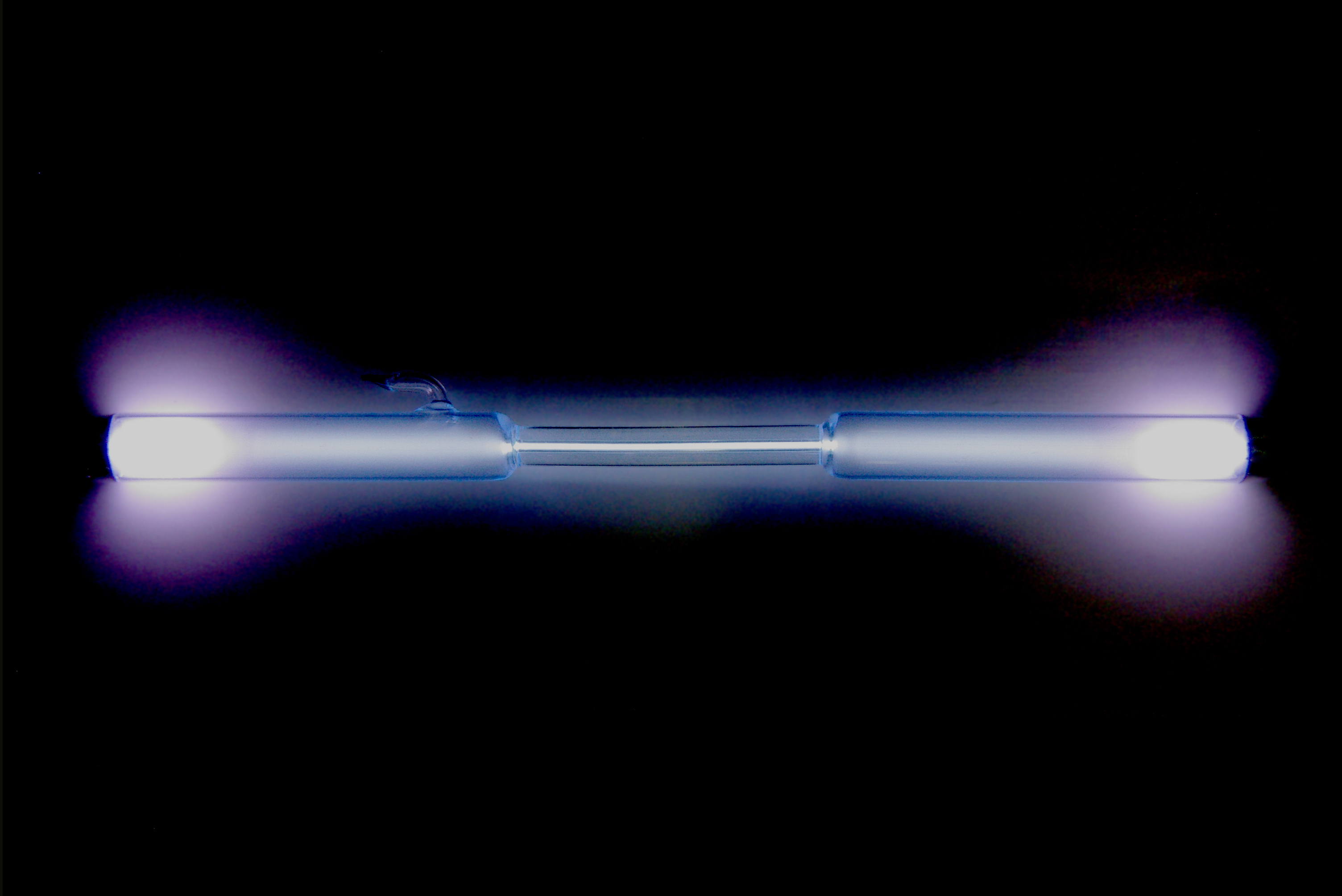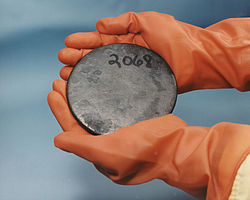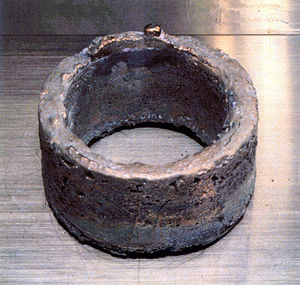Plutonium-238
Plutonium-238 is an isotope of plutonium. It is a radioactive substance extensively used as a longstanding fuel source in space probes.
Plutonium-238 Identification
The CAS Registry Number for this radioactive isotope is 13981-16-3.
Plutonium-238 History
Among the different isotopes of plutonium, Pu-238 was the first to be discovered. In 1941, Glenn Seaborg and associates bombarded uranium-238 using deuterons to synthesize Plutonium-238. The intermediate product Neptunium-238 goes through decomposition to form Plutonium-238.
Plutonium-238 Nucleus
There are 144 Neutrons and 94 Protons in the Plutonium-238 isotope.
Plutonium-238 Symbol
The symbol denoting Plutonium-238 is written as 238Pu.
Plutonium-238 Production
Plutonium-238 can be produced by hitting uranium-238 with deuterons. This method is expressed in the following reaction.
238U92 + 2D1 → 238Np93 + 21n0
238Np93 → 238Pu94
In the above reaction, Uranium-238 is hit by a deuteron that produces Neptunium-238 and two neutrons. Neptunium-238 then undergoes spontaneous decomposition through the emission of negatively charged beta particles and forms Plutonium-238 in the process.
Pure Plutonium-238 can be generated by irradiating americium in a nuclear reactor or by irradiating neptunium-237 which is a minor actinide derived while reprocessing spent nuclear fuel. In each case, the derived components are then subjected to a chemical reaction. This involves dissolving the components in nitric acid for extracting Pu-238 from them.
Reactor-grade plutonium obtained from spent nuclear fuel consists of several plutonium isotopes, out of which only 1% or 2% is Plutonium-238. However, due to its brief half-life, this small percentage is probably responsible for most of the short-term decay heat produced from the spent nuclear fuel. This is not an effective way of manufacturing Plutonium-238 for Radioisotope Thermoelectric Generators (RTGs) as the spent nuclear fuel would have to go through a difficult process of isotopic separation.
Plutonium-238 Properties
The various Plutonium-238 properties have been discussed below:
Appearance
It is a solid, bright silvery metal.
Critical Mass
The critical mass of Plutonium-238 for a bare sphere is 10 kg.
Critical Diameter
The critical diameter of Plutonium-238 for a uniform sphere is 9.7 cm.
Isotope Mass
The Isotope mass of Plutonium-238 is 238.049553 u.
Decay Mode
Plutonium-238 decay modes include alpha emission, spontaneous fission, 32Si cluster emission, and 28Mg + 30Mg double cluster emission.
Decay Energy
The energy released by Plutonium-238 during decomposition is 5.593 MeV.
Branching Ratio
The branching ratio for Plutonium-238 while decaying through alpha emission is 100%.
The branching ratio for Plutonium-238 while decaying through spontaneous fission is 1.9 x 10-9.
The branching ratio for Plutonium-238 while decaying through 32Si cluster emission is 1.4 x 10-16.
The branching ratio for Plutonium-238 while decaying through 28Mg + 30Mg double cluster emission is 6 x 10-17.
Daughter Nuclide
Uranium-234 is produced as a daughter nuclide when Pu-238 undergoes decomposition.
Magnetic Dipole Moment
The magnetic dipole moment of Plutonium-238 is 0 μN.
Spin Parity
Spin parity of Pu-238 is represented as Jπ = 0+ (atomic boson).
Binding Energy
The binding energy per nucleon of Pu-238 is 7.568354 MeV.
Specific Activity
The specific activity SA of Plutonium-238 is 634 GBq/g.
Plutonium-238 Half-Life
In radioactivity, the half-life is the time taken by a specific amount of a radioactive substance that undergoes decomposition to be decreased by half. The half-life of Plutonium-238 is 87.7 years.
Plutonium-238 Radioactive Decay
The unstable atomic nucleus of Plutonium-238 loses energy in order to reach a stable stage. This reaction is defined as radioactive decay. Plutonium-238 releases around 5.593 MeV of energy through radioactive decay.
Plutonium-238 Decay Equation
The alpha decomposition of Plutonium-238 is shown in the equation below:
238Pu94 → 234U92 + 4He2
The helium nucleus 24He in this reaction equation has got atomic number 2 and mass number 4. Helium here indicates the alpha particle. This reaction can also be represented in the following way:
238Pu94 → 234U92 + α
Plutonium-238 Decay Chain
Plutonium-238 goes through decomposition to produce Uranium-234 as the daughter nuclide. At the end of this Alpha decay chain, the stable element that is produced is Lead-206. The complete decay chain is expressed in the following reaction:
Plutonium-238 → Uranium-234 → Radium-226 → Radon-222 → Polonium-218 → Lead-214 → Bismuth-214 → Polonium-214 → Lead-210 → Bismuth-210 → Polonium-210 → Lead-206
Plutonium-238 Fission
Plutonium-238 is not a fissile material and so it is incapable of sustaining chain reactions. However, this substance is fissionable when struck by high-energy neutrons.
Plutonium-238 Uses
The various uses of Plutonium-238 are described below:
- Plutonium-238 is a very strong alpha particle emitter. Since the chances of getting other forms of more powerful and penetrating radiation are minimal, this isotope of Plutonium is used in radioisotope heater units and Radioisotope Thermoelectric Generators (RTGs).
- This substance produces almost 0.5 watts of heat per gram. It is thus used as an important source of power for fuelling interplanetary probes and unmanned spacecraft. Nuclear batteries using Pu-238 have been used in the Voyager and Pioneer space probes.
- Trace amounts of Plutonium-238 were also used in manufacturing early pacemaker batteries.
- A combination of Pu-238 and beryllium produces neutrons that are used for research purposes.
Plutonium-238 Contamination and Health Risks
Plutonium-238 is a dangerous carcinogenic substance. Like Pu-239, Pu-238 is hard to locate once it enters the body and has been absorbed by it.
The main health hazards come from the alpha (α) radiation emitted by Pu-238. These particles are much heavier than the beta and gamma radiation particles and so when they are within the body, they constantly bombard a particular area thereby causing cancer.
Traces of Plutonium-238 mostly get lodged in soft tissues, like in the bone marrow, the liver, on bone surfaces, and other non-calcified bony structures. The major threat to human health comes from inhaling this radioactive substance. This can damage the cells and tissues of the lungs and the bronchial tubes. The substance can also enter the body through cuts and abrasions and be absorbed into the bloodstream.
Plutonium-238 is one of the most indispensable of all the radioactive isotopes. Without it, the cause of space research would have been much more difficult to pursue.
- References
- http://www.chemicool.com/elements/plutonium.html
- http://www.wolframalpha.com/input/?i=Pu-238
- http://www.ieer.org/fctsheet/pu-props.html
- http://www.ieer.org/ensec/no-3/puhealth.html






thank you very much for helping me with my science project.
i can see how this is useful
this is a very good page
My essay is due in 3 hours help me!
I need to know how to manage the risks of Pu-238. Please help, fast!
this may be a bit late but it gives off alpha radiation particles, which have little penetrating power, so simple and low-level shielding should do it